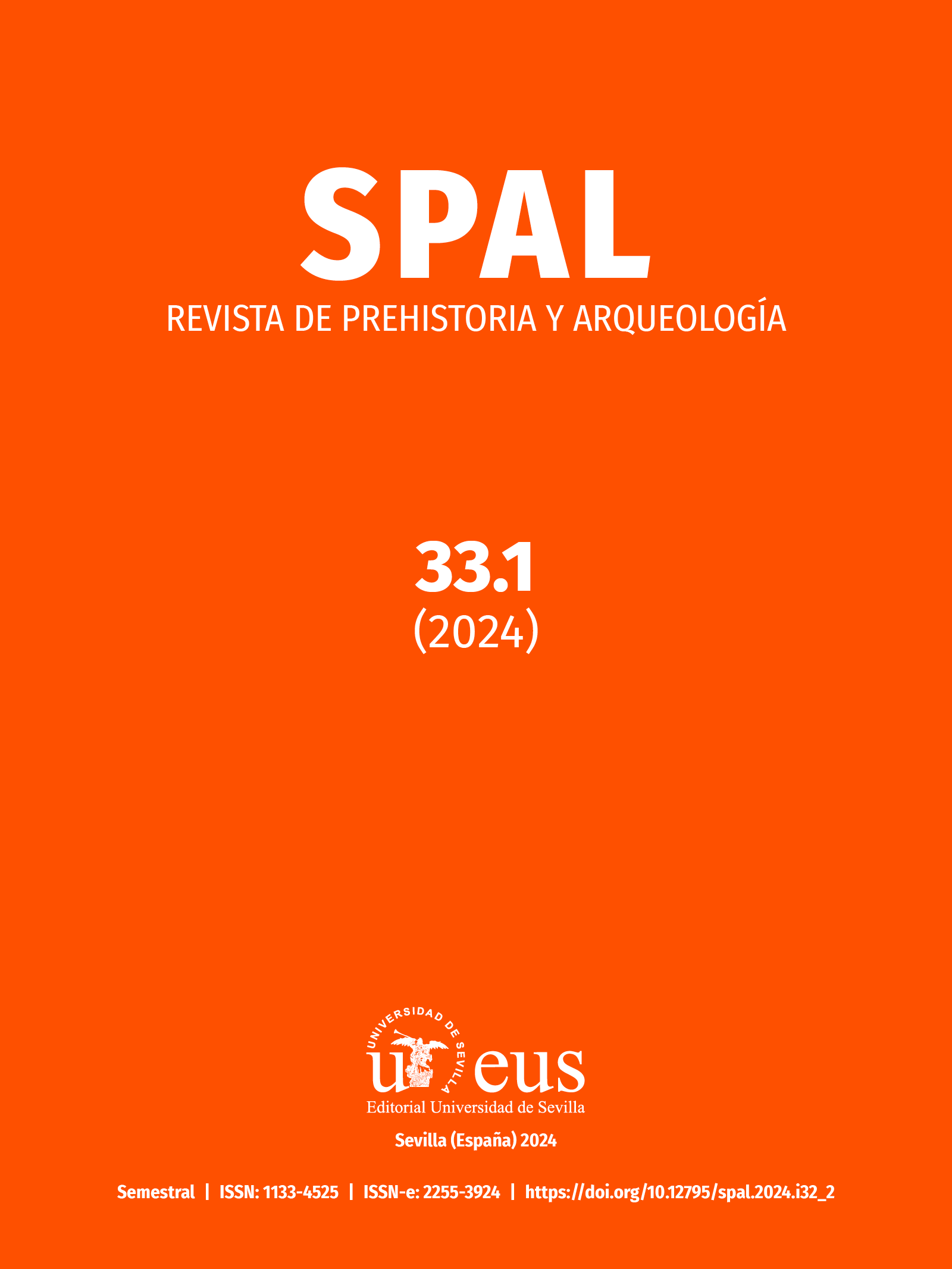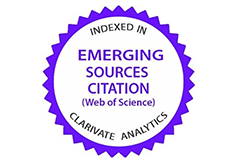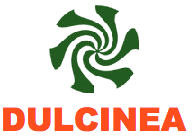Roman-indigenous interaction in the Salas River valley (Northwest Iberia): the Roman camp of Alto da Raia and its archaeological landscape
DOI:
https://doi.org/10.12795/spal.2024.i33.06Palabras clave:
Campamento romano, Teledetección, Geofísica, Datación por radiocarbono y luminiscencia, Geoquímica, ArqueobotánicaResumen
Este trabajo aborda la investigación arqueológica y la contextualización histórica del recinto del Alto da Raia, situado en la frontera entre el norte de Portugal y Galicia, identificado como posible campamento romano, siguiendo un enfoque interdisciplinar y multiproxy. Esto incluyó excavación arqueológica, teledetección y prospección geofísica, así como recogida de muestras para estudios arqueobotánicos y geoquímicos mediante análisis químicos y mineralógicos y datación absoluta mediante protocolos de radiocarbono y luminiscencia.
Los resultados parecen indicar que este yacimiento fue un campamento romano y que fue construido y ocupado probablemente entre el siglo I a.C. y el siglo I d.C., cuando se produjeron importantes cambios en el noroeste de Iberia impulsados por la expansión del Estado romano. El campamento se solapa con ocupaciones prehistóricas anteriores que posiblemente se remontan a la Edad del Bronce y a la Edad del Hierro.
Descargas
Citas
Aitken, M. (1999) “Archaeological dating using physical phenomena”, Reports on Progress in Physics, 62, pp. 1333-1376. https://doi.org/10.1088/0034-4885/62/9/202
Anderberg, A. L. (1994) Atlas of seeds and small fruits of Northwest-European plant species with morphological descriptions. Stockholm: Swedish Museum of Natural History.
Arabaolaza, I. (2019) “A Roman Marching Camp in Ayr”, Britannia, 50, pp. 330-349. https://doi.org/10.1017/S0068113X19000059
Armada, X. L. and García-Vuelta, O. (2015) “Dating Iron Age goldwork: First direct AMS 14C results from Northwestern Iberia”, Trabajos de Prehistoria, 72(2), pp. 272-282. https://doi.org/10.3989/tp.2015.12160
Armada, X. L. and García-Vuelta, O. (2021) “Plano-convex ingots and precious metalwork in northwestern Iberia during the Late Iron Age and early Roman period: An analytical approach”, Archaeological and Anthropological Sciences, 13(78). https://doi.org/10.1007/s12520-021-01323-2
Bahlburg, H. and Dobrzinski, N. (2011) “A review of the Chemical Index of Alteration (CIA) and its application to the study of Neoproterozoic glacial deposits and climate transitions”, in Arnaud, E., Halverson, G.P. and Shields, G.A. (eds.) The Geological Record of Neoproterozoic Glaciations, 36. London: Geological Society of London, pp. 81-92. https://doi.org/10.1144/M36.6
Bettencourt, A. M. S. (1999) A Paisagem e o Homem na bacia do Cávado durante o II e o I milénios AC. PhD thesis. Universidade do Minho. (Available at https://hdl.handle.net/1822/83209, accessed on November 2023).
Biscaye, P.E. (1965) “Mineralogy and sedimentation of recent deep-sea clay in the Atlantic Ocean and adjacent seas and oceans”, Geological Society of America Bulletin, 76, pp. 803-832.
Brindley, G.W. and Brown, G. (1980) Crystal structures of clay minerals and their X-ray identification. London: Mineralogical Society.
Bronk Ramsey, C. (2009) “Bayesian Analysis of Radiocarbon Dates”, Radiocarbon, 51(1), pp. 337-360. https://doi.org/10.1017/S0033822200033865
Brudenell, M. and Cooper, A. (2008) “Post-middenism: depositional histories on later Bronze Age settlements at Broom, Bedfordshire”, Oxford Journal of Archaeology, 27, pp. 15-36. https://doi.org/10.1111/j.1468-0092.2007.00293.x
Burbidge, C. I., Trindade, M. J., Dias, M. I., Oosterbeek, L., Scarre, C., Rosina, P., Cruz, A., Cura, S., Cura, P., Caron, L., Prudêncio, M. I., Cardoso, G. J. O., Franco, D., Marques, R. and Gomes, H. (2014) “Luminescence dating and associated analyses in transition landscapes of the Alto Ribatejo, Central Portugal”, Quaternary Geochronology, 20, pp. 65-77. https://doi.org/10.1016/j.quageo.2013.11.002
Cavallo, C., Kooistra, L. I. and Dütting, K. K. (2008) “Food supply to the Roman army in the Rhine delta in the first century A.D.”, in Stallibrass, S. and Thomas, R. (eds.) Feeding the Roman Army: The Archaeology of Production and Supply in NW Europe. Oxford: Oxbow Books, pp. 69-82.
Centeno, R. (2011) “Da República ao Império: Reflexões sobre a monetização no ocidente da Hispania”, in García-Bellido, M. P., Callegarin, L. and Jiménez, A. (eds.) Barter, Money and Coinage in the Ancient Mediterranean (10th-1st Centuries BC). Madrid: CSIC, pp. 355-367.
Costa-García, J. M., Fonte, J. and Gago, M. (2019) “The reassessment of the Roman military presence in Galicia and northern Portugal trough digital tools: archaeological diversity and historical problems”, Mediterranean Archaeology and Archaeometry, 19(3), pp. 17-49. https://doi.org/10.5281/zenodo.3457524
Doneus, M. (2013) “Openness as Visualization Technique for Interpretative Mapping of Airborne Lidar Derived Digital Terrain Models”, Remote Sensing 5, pp. 6427-6442. https://doi.org/10.3390/rs5126427
Duller, G. (2003) “Distinguishing quartz and feldspar in single grain luminescence measurements”, Radiation Measurements, 37, pp. 161-165. https://doi.org/10.1016/S1350-4487(02)00170-1
Eguileta Franco, J. M. (2003) Mámoas y paisaje, muerte y vida en Val de Salas (Ourense): el fenómeno megalítico en un valle de montaña. Vigo: Universidade de Vigo.
Eixea, A., Bel, M. Á., Carrión, Y., Ferrer-García, C., Guillem, P. M., Martínez-Alfaro, A., Martínez-Varea, C. M., Moya, R., Rodrigues, A. L., Dias, M. I., Russo, D. and Sanchis, A. (2023) “A multi-proxy study from new excavations in the Middle Palaeolithic site of Cova del Puntal del Gat (Benirredrà, València, Spain)”, Comptes Rendus Palevol, 22(10), pp. 159-200. https://doi.org/10.5852/cr-palevol2023v22a10
Figueiral, I. (1990) Le Nord-Ouest du Portugal et les modifications de l’ecosysteme, du Bronze final a l’epoque romaine, d’apres l’anthracoanalyse de sites archeologiques. PhD thesis. Université des Sciences et Techniques du Languedoc.
Figueiredo, E., Rodrigues, A., Fonte, J., Meunier, E., Dias, F., Lima, A., Gonçalves, J. A., Gonçalves-Seco, L., Gonçalves, F., Pereira, M. F. C., Silva, R. J. C. and Veiga, J.P. (2022) “Tin and Bronze Production at the Outeiro de Baltar Hillfort (NW Iberia)”, Minerals, 12(6), 758. https://doi.org/10.3390/min12060758
Fonte. J. (2022) “Late Iron Age and early Roman conflict and interaction in southern Callaecia (north-west Iberia)”, in Stek, T. D. and Carneiro, A. (eds.) The Archaeology of Roman Portugal in its Western Mediterranean Context. Oxford: Oxbow Books, pp. 27-46.
Fonte, J., Costa-García, J. M. and Gago, M. (2022) “O Penedo dos Lobos: Roman military activity in the uplands of the Galician Massif (Northwest Iberia)”, Journal of Conflict Archaeology, 17(1), pp. 5-29. https://doi.org/10.1080/15740773.2021.1980757
Fonte, J., Rodrigues, A. L., Dias, M. I., Russo, D., Pereiro, T., Carvalho, J., Amorim, S., Jorge, C., Monteiro, P., Ferro-Vázquez, C., Costa-García, J.M., Gago, M. and Oltean, I. (2023) “Reassessing Roman military activity through an interdisciplinary approach: Myth and archaeology in Laboreiro Mountain (Northwestern Iberia)”, Journal of Archaeological Science: Reports, 49, 103993. https://doi.org/10.1016/j.jasrep.2023.103993
García Sánchez, J., Costa-García, J. M., Fonte, J. and González-Álvarez, D. (2022) “Exploring Ephemeral Features with Ground-Penetrating Radar: An Approach to Roman Military Camps”, Remote Sensing 14, 4884. https://doi.org/10.3390/rs14194884
González-Álvarez, D., Costa-García, J. M., Menéndez-Blanco, A., Fonte, J., Álvarez-Martínez, V., Blanco-Rotea, R. and Gago, M. (2019) “La presencia militar romana en el noroeste ibérico hacia el cambio de era: estado actual y retos de futuro”, in Vallori Márquez, B., Rueda Galán, C. and Bellón Ruiz, J. P. (eds.) Accampamenti, guarnigioni e assedi durante la Seconda Guerra Punica e la conquista romana (secoli III-I a.C.): prospettive archeologiche. Roma: Edizioni Quasar, pp. 127-138.
Haskins, D. (2006) Chemical and mineralogical weathering indices as applied to a granite saprolite in South Africa. IAEG2006 Paper number 465. London: The Geological Society of London.
Hesse, R. (2010) “LiDAR-derived Local Relief Models – a new tool for archaeological prospection”, Archaeological Prospection, 17, pp. 67-72. https://doi.org/10.1002/arp.374
Howland, M. D., Tamberino, A., Liritzis, I. and Thomas, E. L. (2022) “Digital Deforestation: Comparing Automated Approaches to the Production of Digital Terrain Models (DTMs) in Agisoft Metashape”, Quaternary, 5(1), 5. https://doi.org/10.3390/quat5010005
Johnson, M.J. (1993) “The system controlling the composition of clastic sediments”, in Johnsson, M.J. and Basu, A. (eds.) Processes controlling the composition of clastic sediments. Geological Society of America Special Paper, 285, pp. 1-19. https://doi.org/10.1130/SPE284-p1
Kenney, J. and Parry, L. (2012) “Excavations at Ysgol yr Hendre, Llanbeblig, Caernarfon: a possible construction camp for Segontium fort and early medieval cemetery”, Archaeologia Cambrensis, 161, pp. 249-284. https://doi.org/10.5284/1059189
Kokalj, Ž. and Somrak, M. (2019) “Why Not a Single Image? Combining Visualizations to Facilitate Fieldwork and On-Screen Mapping”, Remote Sensing, 11(7), 747. https://doi.org/10.3390/rs11070747
Lorenzo Fernández, J. (1970). “Tesorillo protohistórico de Calvos de Randín”, Archivo Español de Arqueología, 43, pp. 228-232.
Magalhães, C. (2020) Achas na Fogueira. Estudo antracológico do Castro de Guifões (Matosinhos). MSc thesis. Faculdade de Letras da Universidade do Porto. (Available at https://hdl.handle.net/10216/131415, accessed on November 2023).
McParland, L. C., Collinson, M. E., Scott, A.C., Campbell, G. and Veal, R. (2010) “Is vitrification in charcoal a result of high temperature burning of wood?”, Journal of Archaeological Science, 37, pp. 2679-2687. https://doi.org/10.1016/j.jas.2010.06.006
Marguerie, D. and Hunot, J. Y. (2007) “Charcoal analysis and dendrology: data from archaeological sites in north-western France”, Journal of Archaeological Science, 34, pp. 1417-1433. https://doi.org/10.1016/j.jas.2006.10.032
Marques, R., Prudêncio, M. I., Russo, D., Cardoso, G., Dias, M. I., Rodrigues, A. L., Reis, M., Santos, M. and Rocha, F. (2021) “Evaluation of naturally occurring radionuclides (K, Th and U) in volcanic soils from Fogo Island, Cape Verde”, Journal of Radioanalytical and Nuclear Chemistry, 330, pp. 347-355. https://doi.org/10.1007/s10967-021-07959-7
Martín-Pozas, J. M. (1968) El análisis mineralógico cuantitativo de los filosilicatos de la arcilla por difracción de rayos X. PhD thesis. Universidad de Granada.
Martins, M. (1987) “A cerâmica proto-histórico do vale do Cávado: tentativa de sistematização” Cadernos de Arqueologia, 4, pp. 35-77.
Martins, M. (1990) Povoamento proto-histórico e a romanização da bacia do curso médio do Cávado. Cadernos de Arqueologia - Monografias 5. Braga: Unidade de Arqueologia da Universidade do Minho.
Martins, J. A. and Ribeiro, M. L. (1979) Notícia Explicativa da Folha 2-C Tourém. Carta Geológica de Portugal na escala de 1/50000. Lisboa: Direcção-Geral de Geologia e Minas, Serviços Geológicos de Portugal.
Morillo, Á., Adroher, A., Dobson, M. and Martín Hernández, E. (2020) “Constructing the archaeology of the Roman conquest of Hispania: new evidence, perspectives and challenges”, Journal of Roman Archaeology, 33, pp. 36-52. https://doi.org/10.1017/S1047759420000902
Murray, A. S. and Wintle, A. G. (2000) “Luminescence dating of quartz using an improved single-aliquot regenerative-dose protocol”, Radiation Measurements, 32, pp. 57-73. https://doi.org/10.1016/S1350-4487(99)00253-X
Murray, A. S. and Wintle, A. G. (2003) “The single aliquot regenerative dose protocol: Potential for improvements in reliability”, Radiation Measurements, 37, pp. 377-381. https://doi.org/10.1016/S1350-4487(03)00053-2
Neef, R., Cappers, R. and Bekker, R. (2012) Digital atlas of economic plants in archaeology. Groningen: Barkhuis and Groningen University Library.
Odriozola, C. P., Burbidge, C. I., Dias, M. I. and Hurtado, V. (2014) “Dating of Las Mesas Copper Age walled enclosure (La Fuente, Spain)”, Trabajos de Prehistoria, 71, pp. 343-352. https://doi.org/10.3989/tp.2014.12138
Peña-Chocarro, L., Pérez- Jordà, G., Alonso, N., Antolín, F., Teira-Brión, A., Tereso, J. P., Montes Moya, E. M. and López Reyes, D. (2019) “Roman and medieval crops in the Iberian Peninsula: A first overview of seeds and fruits from archaeological sites”, Quaternary International, 499, pp. 49-66. https://doi.org/10.1016/j.quaint.2017.09.037
Peralta Labrador, E. (2002) “Los campamentos romanos de campaña (castra aestiva): evidencias científicas y carencias académicas”, Nivel Cero: revista del grupo arqueológico Attica, 10, pp. 49-87.
Peralta Labrador, E., Camino Mayor, J. and Torres-Martínez, J. F. (2019) “Recent research on the Cantabrian Wars: the archaeological reconstruction of a mountain war”, Journal of Roman Archaeology, 32, pp. 421-438. https://doi.org/10.1017/S1047759419000217
Puente, I., Solla, M., Lagüela, S. and Sanjurjo-Pinto, J. (2018) “Reconstructing the Roman site “Aquis Querquennis” (Bande, Spain) from GPR, T-LiDAR and IRT data fusion”, Remote Sensing, 10(3), 379. https://doi.org/10.3390/rs10030379
Reimer, P.J., Austin, W.E.N., Bard, E., Bayliss, A., Blackwell, P.G., Bronk Ramsey, C., Butzin, M., Cheng, H., Edwards, R.L., Friedrich, M., Grootes, P.M., Guilderson, T.P., Hajdas, I., Heaton, T.J., Hogg, A.G., Hughen, K.A., Kromer, B., Manning, S.W., Muscheler, R., Palmer, J.G., Pearson, C., van der Plicht, J., Reimer, R.W., Richards, D.A., Scott, E.M., Southon, J.R., Turney, C.S.M., Wacker, L., Adophi, F., Büntgen, U., Capano, M., Fahrni, S., Fogtmann-Schulz, A., Friedrich, R., Kudsk, S., Miyake, F., Olsen, J., Reinig, F., Sakamoto, M., Sookdeo, A., Talamo, S. (2020) “The IntCal20 Northern Hemisphere Radiocarbon Age Calibration Curve (0–55 cal kBP)” Radiocarbon, 62(4), pp. 725-757. https://doi.org/10.1017/RDC.2020.41
Rodrigues, A. L., Burbidge, C. I., Dias, M. I., Rocha, F., Valera, A. C. and Prudêncio, M. I. (2013) “Luminescence and mineralogy of profiling samples from negative archaeological features”, Mediterranean Archaeology and Archaeometry, 13(3), pp. 37-47.
Rodrigues, A.L., Dias, M. I., Valera, A. C., Rocha, F., Prudêncio, M. I., Marques, R., Cardoso, G. and Russo, D. (2019) “Geochemistry, luminescence and innovative dose rate determination of a Chalcolithic calcite-rich negative feature”, Journal of Archaeological Science: Reports, 26, 101887. https://doi.org/10.1016/j.jasrep.2019.101887
Rodrigues, A. L., Marques, R., Dias, M. I., Prudêncio, M. I., Cardoso, G., Russo, D., Rafel, N. and Soriano, E. (2022) “Luminescence and compositional studies for the identification of “fire-setting” features at prehistoric mine La Turquesa (Catalonia, Spain)”, Journal of Radioanalytical and Nuclear Chemistry, 331, pp. 1397-1408. https://doi.org/10.1007/s10967-022-08198-0
Rodríguez Colmenero, A. and Ferrer Sierra, S. (eds.) (2006) Excavaciones arqueológicas en Aquis Querquennis. Actuaciones en el campamento romano (1975-2005). Lugo: Unión Fenosa/Grupo Arqueolóxico Larouco/Universidade de Santiago de Compostela/Fundación Aquae Querquennae-Vía Nova.
Salido Domínguez, J. (2020) “Un modelo de implantación de Roma en el Noroeste peninsular: la construcción de graneros sobreelevados en los castros”, Anejos. Cuadernos de Prehistoria y Arqueología de la UAM, 4, pp. 259-271. https://doi.org/10.15366/ane4.ochoa2020.020
Seabra, L., Santos, F., Vaz, F. C., Leite, J. and Tereso, J. P. (2020) “Crops behind closed walls: fortified storage at Castelinho in the Late Iron Age of NW Iberia”, Journal of Archaeological Science: Reports, 30, 102200. https://doi.org/10.1016/j.jasrep.2020.102200
Seabra, L., Carvalho, J., Ramos, R., Martín-Seijo, M., Almeida, R. and Tereso, J.P. (2023) “Arqueobotânica com vista para o Douro: frutos e sementes do sítio do Rei Ramiro (Vila Nova de Gaia, Norte de Portugal)”, in Fernandes, I., Santos, M. and Correia, M. (eds.) Amanhar a terra. Arqueologia da agricultura [Do Neolítico ao Período Medieval]. Palmela: Município de Palmela, pp. 267-282.
Schultz, L. G. (1964) Quantitative interpretation of mineralogical composition X-ray and chemical data for the Pierre Shale. US Geological Survey Professional Paper, 391.
Schweingruber, F. H. (1990) Anatomy of European Woods: An Atlas for the Identification of European Trees, Shrubs and Dwarf Shrubs. Bern: Paul Haupt.
Teira Brión, A. (2019) Cambio e resiliencia na agricultura e xestión de recursos vexetais no NW da Península Ibérica (1000 a.n.e.–400 d.n.e.). PhD thesis. Universidade de Santiago de Compostela. (Available at http://hdl.handle.net/10347/20497, accessed on November 2023).
Tereso, J.P., Ramil-Rego, P. and Almeida-da-Silva, R. (2013) “Roman agriculture in the conventus Bracaraugustanus (NW Iberia)”, Journal of Archaeological Science, 40, pp. 2848-2858. http://dx.doi.org/10.1016/j.jas.2013.01.006
Tereso, J. P., Vaz, F.C., Silva, S. A. and Silva, A. (2023) “Consumo de plantas cultivadas e silvestres em Salreu (Estarreja, Aveiro) durante a Idade do Ferro”, in Fernandes, I., Santos, M. and Correia, M. (eds.) Amanhar a terra. Arqueologia da agricultura [Do Neolítico ao Período Medieval]. Palmela: Município de Palmela, pp- 213-224.
Théry-Parisot, I. and Henry, A. (2012) “Seasoned or green? Radial cracks analysis as a method for identifying the use of green wood as fuel in archaeological charcoal”, Journal of Archaeological Science, 39, pp. 381-388. https://doi.org/10.1016/j.jas.2011.09.024
Trindade, M. J., Dias, M. I., Coroado, J. and Rocha, F. (2010) “Firing Tests on Clay-Rich Raw Materials from the Algarve Basin (Southern Portugal): Study of Mineral Transformations with Temperature”, Clays and Clay Minerals, 58, pp. 188-204. https://doi.org/10.1346/CCMN.2010.0580205
Vaz, F. C., Tereso, J. P., Lemos, P. and Abranches, P. (2016) “Estudo arqueobotânico do Castro de Cidadelhe (Mesão Frio): resultados preliminares”, Estudos do Quaternário, 15, pp. 59-69. https://doi.org/10.30893/eq.v0i15.133
Vázquez Mato, M. X. (2021) “O Castro de Saceda (Cualedro). Historiografia, caracterización e cronoloxía”, Raigame, 45, pp. 92-101.
Verhoeven, G. (2011) “Taking computer vision aloft – archaeological three-dimensional reconstructions from aerial photographs with photoscan”, Archaeological Prospection, 18, pp. 67-73. https://doi.org/10.1002/arp.399
Vernet, J.L., Ogereau, P., Figueiral, I., Machado Yanes, C. and Uzquiano, P. (2001) Guide d’identification des charbons de bois préhistoriques et récents. Sud-ouest de l’Europe: France, Péninsule ibérique et Îles Canaries. Paris: CNRS Editions.
Villar, L. (1990) “Polygonum L.”, in Castroviejo, S., Laínz, M., López González, G., Montserrat, P., Muñoz Garmendia, F., Paiva, J. and Villar. L. (eds.) Flora iberica. Plantas vasculares de la Península Ibérica e Islas Baleares. Vol II Platanaceae-Plumbaginaceae (partim). Madrid: Real Jardín Botánico/CSIC, 571-586.
Zakšek, K., Oštir, K. and Kokalj, Ž. (2011) “Sky-View Factor as a Relief Visualization Technique”, Remote Sensing, 3 (2), pp. 398-415. https://doi.org/10.3390/rs3020398
Descargas
Publicado
Cómo citar
Número
Sección
Licencia
Derechos de autor 2024 SPAL - Revista de Prehistoria y Arqueología

Esta obra está bajo una licencia internacional Creative Commons Atribución-NoComercial-CompartirIgual 4.0.









